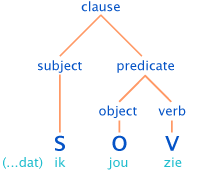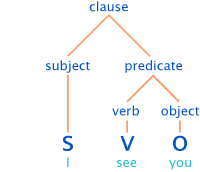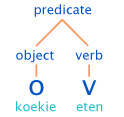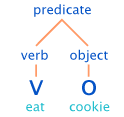

Syntax: Word order
As you have seen in the previous chapter, word order is important in both Dutch and English. Unfortunately for English people learning Dutch, the rules are not the same in both languages. In the following sentence you can see the word order in English:
| Noam | told | you | (that) | Steven | likes | linguistics. |
| subject | verb | object | subject | verb | object |
Because of the set order in the sentences (subject ![]() verb
verb ![]() object)
English is known as an >SVO-language.
object)
English is known as an >SVO-language.
Even though on the surface the order of the words can deviate from the English SVO word order, linguists assume that the basic order of all English sentences is SVO. This makes more sense than you might think:
| You | have | seen | Martians. | |
| subject | verb | object |
|
|
| You | have | seen | what? | (ungrammatical unless you stress ‘what’, in a so-called echo question) |
| subject | verb | object |
|
|
| What | have | you | seen? | |
| object | subject | verb |
The most natural position for ‘what’ seems to be at the end of the sentence (because it ‘replaces’ Martians). However, apparently there is a rule in English that question words (or wh-words (where, what etc.)) have to be in the first position. Linguists say the word ‘what’ moves to the front of the sentence. The >underlying word order is still assumed to be SVO.
Dutch word order
How about the word order in Dutch? Let’s look at a simple sentence first, pay close attention to the position of subject, object and verb:
| Thijs | vertelde | het | aan | jou. |
| Thijs | told | it | to | you |
| subject | verb | d.o. | i.o. |
(d.o. and i.o. stand for >direct object and >indirect object, see glossary)
At first sight Dutch seems to have SVO-order as well. Now look at a more complex sentence:
| Thijs | vertelde | (aan) jou | dat | Riny | linguistiek | leuk | vindt. |
| Thijs | told | (to)you | that | Riny | linguistics | nice | finds. |
| subject | verb | object | subject | object | verb | ||
| ‘Thijs told you that Rini likes linguistics’ | |||||||
Note that this sentence is almost the same as ‘Noam told you that Steven likes linguistics’. It seems that there are two ‘sentences’:
Thijs/Noam vertelde (het) aan jou - Thijs/Noam told you (something).
Riny/Steven vindt linguistiek leuk - Riny/Steven likes linguistics.
As you probably noticed, in Dutch the word order of the second sentence changes when we put these two together. ‘Riny vindt linguistiek leuk’ is the SVO-order we have seen before (Check for yourself if this is true!) but in the ‘big sentence’ it changes to ‘(dat) Riny linguistiek leuk vindt’ which is SOV-order! Note that this change in word-order does not occur in the English sentence, it is a peculiar feature of Dutch.
Determine the word order in the following sentences.
Constituent structure
At this point it is important to introduce some new concepts, because we need to look into the sentences above in a little more detail.
A >predicate is that part of the sentence which is not the subject. For example, if we take the subject of a sentence ‘Aristotle’ we can make different sentences by adding different *predicates to this subject:
| subject | predicate | |
| Aristoteles | is slim | - is clever |
| koopt een auto | - buys a car | |
| houdt van zwemmen | - likes to swim | |
| gaat naar huis | - goes home |
Now we know this, we can learn a little more about >grammatical units. The sentence is a big piece, which consists of smaller pieces (subject and predicate), which consist of yet smaller pieces (words). This hierarchical build up of sentences is called >constituent structure. Every single ‘piece’ of the sentence is called a >constituent.
The biggest *constituent is the sentence. The largest grammatical unit smaller than a sentence is a >clause. A *clause is a constituent consisting of a subject and a predicate. A sentence must consist of at least one clause, but can have more than one clause. A >compound sentence consists of two equal clauses put together in a sentence (>Trask).
Susanne gaat naar Engeland en Linda blijft in Nederland.
Susanne goes to England and Linda stays in The Netherlands.
Notice that in this example the word order in both English and Dutch are the same in both clauses (>SVO).
A >complex sentence consists of two or more clauses of which one outranks the others (>Trask):
| Thijs | vertelde | jou | dat | Riny | linguistiek | leuk | vindt. |
| Thijs | told | you | that | Riny | linguistics | nice | finds (likes). |
| ‘Thijs told you that Rini likes linguistics’ | |||||||
Notice that the word order in the second clause is not the same in English and Dutch (SVO vs SOV).
The highest-ranking, or only, clause in a sentence is called the >main clause. In a complex sentence the clause that is outranked, or subordinated, is called the >subordinate clause (>sub-clause in short). The *sub-clause is part of the larger clause (in this case it is the object of the main clause). There may be more than one sub-clause in a sentence.
The main information in the sentence above is that ‘Thijs told you something’. This main clause is fine just by itself; it can be a sentence on its own. The sub-clause gives us more information on what that something was. Sub-clauses often start with a >complementizer, for example ‘dat’ (that) or a *conjunction (and/or): ‘Thijs told you [that Riny likes linguistics]’. This sub-clause ‘completes’ the information of the main clause, and is therefore called a >complement clause. Note that the sub-clause cannot ‘survive’ on its own: ‘* that Riny likes linguistics’ is ungrammatical. The same goes for the Dutch equivalent. The terms main clause and sub-clause simply follow these intuitions.
The hierarchy of a sentence becomes clear if we put the constituents in a tree structure, much like a family tree (Diagram 1):
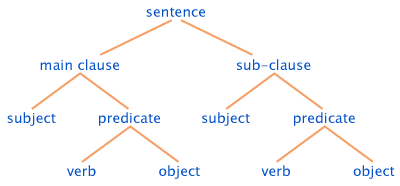
Note that objects are optional and that not every sentence has more than one clause. If there is only one clause, it is the main clause.
Decide if the following sentences are compound sentences or complex sentences.
We now know that the sentence ‘Thijs vertelde jou dat Riny linguistiek leuk vindt’ consists of the main-clause ‘Thijs vertelde jou’ and the sub-clause ‘dat Riny linguistiek leuk vindt’. In Dutch the word order in the main clause and the sub-clause are different:
Riny vindt linguistiek leuk - Riny likes linguistics SVO
…dat Riny linguistiek leuk vindt - …that Riny linguistics likes SOV
The word order in the sub-clause is SOV, and the majority of linguists now agree that Dutch is an >SOV-language. This means that the basic (‘underlying’) order of every Dutch clause is subject-object-verb. If we represent this in a tree structure we get (Diagrams 2 and 3):
DUTCH |
ENGLISH |
Notice that object and verb are in a different order in the two trees. The first tree can be regarded as a representation of Dutch (SOV), whereas the second tree is a representation of English (SVO). The verb can be regarded as the head of the predicate; the Dutch structure is said to be >head-final whereas the English structure is >head-initial. This leads to the Dutch SOV and the English SVO.
This so called >headedness of the predicate is something that children learn when they’re still very young. Where an English infant would say ‘eat cookie’ and ‘drink milk’ a Dutch child will say ‘koekie eten’ and ‘melk drinken’ (Diagrams 4 and 5):
DUTCH |
ENGLISH |
Conclusion
English and Dutch words are very similar and the constituents (predicate, clause, etc.) of a sentence are virtually identical between the languages. However, the languages have a different basic word order and the reason for this is that the underlying structure of both languages is different. Looking at the languages in more detail gave us more insight in how these languages work.
There is one obvious problem that you may have spotted: the word order in Dutch main clauses isn’t SOV at all!
| Jan | leest | een boek. |
| Jan | reads | a book. |
| S | V | O |
An explanation for this is closely tied in with the observation that in a lot of Dutch clauses the verb comes in second place. This is known as >verb second or >V2, and we’ll tell you more about it in the next chapter.
We’ve covered a lot of ground in this chapter and it is important that you don’t feel you’re flooded by information. Don’t worry if you can’t remember all the new words straight away. It is important that you understand that instead of looking at language like a random stream of sounds it is possible to divide language-utterances into different units (constituents for example!). Once we do this we can compare one sentence with another and a sentence of one language with that of another language. Basically, we’re comparing sentence structures, such as the one represented by the tree diagrams.
If the following words sound familiar and you’re confident you know their meaning, it is time to move on to the next chapter:
- SVO or SOV order
- sub and main clause
- sentence
- constituent
- complex sentence (as opposed to compound sentence)
If some things still puzzle you, please take a minute to put things in perspective. It really does make sense once everything sinks in. Don’t forget you’re radically changing the way you look at language, so it is OK if you don’t understand it all in one go!
next![]()
(verb second)

